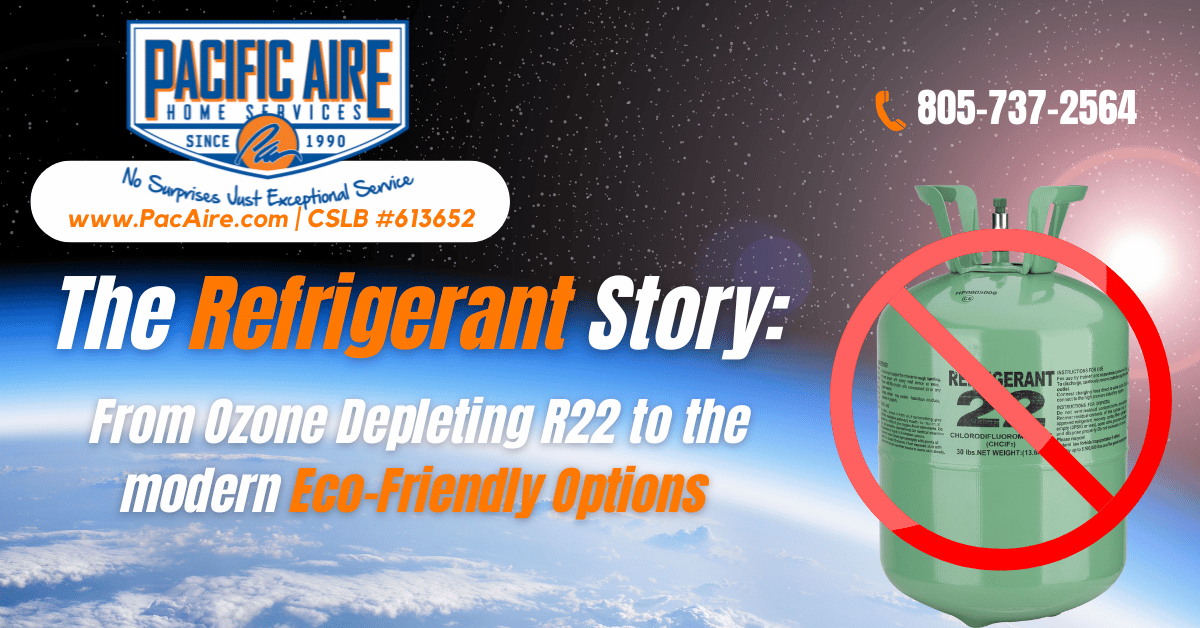As HVAC technology advances, refrigerants have become a critical component of our cooling systems. Refrigerants, which are chemical compounds used in heat pumps and air conditioners, absorb heat from the air and move it outside, leaving us with cool and comfortable indoor temperatures. However, the refrigerants we use today have evolved significantly over the years. In this blog post, we’ll take a look at the evolution of refrigerants and how it has impacted the HVAC industry.
Refrigerant Evolution
1700s-1800s: Refrigeration technology is in its infancy and toxic and flammable substances such as ammonia was used as refrigerants.
1928: Thomas Midgley Jr. invents Freon (R-12), a safer chlorofluorocarbon (CFC) refrigerant widely used in air conditioning and refrigeration systems until the 1990s.
Hydrochlorofluorocarbons (HCFCs) are developed as a transitional substitute for CFCs. R22 becomes the standard refrigerant used in residential air conditioning systems.
1987: The Montreal Protocol is signed, an international agreement to R22 phase out the use of CFCs due to their harmful impact on the ozone layer.
2010: The United States Environmental Protection Agency (EPA) begins phasing out the production and importation of R-22 due to its high ozone depletion potential.
2010s: Hydrofluorocarbons (HFCs) are developed as a replacement for HCFCs. R-410A becomes the standard refrigerant used in residential air conditioning systems.
An overview of the Montreal Protocol
R22, also known as Freon, was the most common HVAC refrigerant used in HVAC systems for decades. However, it has been phased out in recent years due to its harmful effects on the ozone layer. The Montreal Protocol, an international treaty, led to the phase-out of R-22 because it is a hydrochlorofluorocarbon (HCFC), linked to ozone depletion. As a result, HVAC manufacturers stopped producing and importing R22-based air conditioners in 2010, and the production of R-22 refrigerant itself will be completely banned in the US by 2020.
Say goodbye to R-22 and hello to R-410A
The Environmental Protection Agency (EPA) implemented the phase out of R-22 refrigerant in the United States. As R-22 is phased out, R-410A has emerged as the new standard refrigerant for HVAC systems. Unlike R-22, R-410A does not contain chlorine and therefore has no harmful effect on the ozone layer. It is also more energy-efficient and can lead to lower electricity bills for homeowners. As a result, HVAC manufacturers have switched to R-410A for new equipment, and service technicians must now be certified to handle this new HVAC refrigerant.
So, what does this mean for homeowners with older R-22-based HVAC systems? For starters, the cost of R-22 refrigerant has skyrocketed in recent years, as supplies dwindle and the phase-out deadline approaches. This means that even a simple refrigerant recharge can cost hundreds of dollars. Additionally, R-22-based systems are likely to become less efficient over time, as they are unable to take advantage of the benefits of R-410A.
Replacing your HVAC System
For those who are thinking about replacing their HVAC systems, it’s important to choose a system that uses R-410A refrigerant. Not only will this ensure that your system is compliant with current regulations, but it will also lead to lower energy bills and better overall performance.
At Pacific Aire, we specialize in HVAC system installations and repairs, and we can help guide you through the transition from R-22 to R-410A. We offer a range of energy-efficient HVAC systems that use R-410A refrigerant, and our expert HVAC technicians are fully certified to handle this new refrigerant.
But even if you’re not ready to replace your system, it’s important to stay on top of your HVAC maintenance. Regular HVAC service and maintenance can extend the life of your system and help it operate more efficiently. This includes routine inspections, cleaning and lubricating components, and checking refrigerant levels.
The transition from R-22 to R-410A refrigerant has been a major shift in the HVAC industry. While it may mean higher costs for homeowners with older systems, it also presents an opportunity to invest in more energy-efficient and environmentally-friendly HVAC technology. Whether you’re looking to upgrade your system or simply stay on top of your maintenance, Pacific Aire is here to help. Contact us today to learn more about our services and how we can keep your home comfortable and energy-efficient.
Pacific Aire is known for providing reliable, quality heating and air conditioning replacement services.
GET PACIFIC AIRE’S $39 REFRIGERANT CHECK!
During a refrigerant check, our expert technicians will do more than just check your refrigerant levels. We will also assess your system’s airflow, temperature splits, and overall performance. This comprehensive approach ensures that any issues with your AC are identified and addressed, helping to keep your home cool and comfortable all year round.
Refrigerant checks are especially important if you notice that your AC is struggling to keep up with demand. By diagnosing undercharged or overcharged systems, Pacific Aire can recommend the best course of action to optimize your system’s performance.
And don’t forget, a properly charged system not only works better in the short term, but it can also extend the lifespan of your AC. So don’t wait until there’s a problem to schedule a refrigerant check.
Visit https://bit.ly/pacificaire_acreplacement or call us at 805-737-2564 to learn more about how we can help keep your home cool and comfortable.


